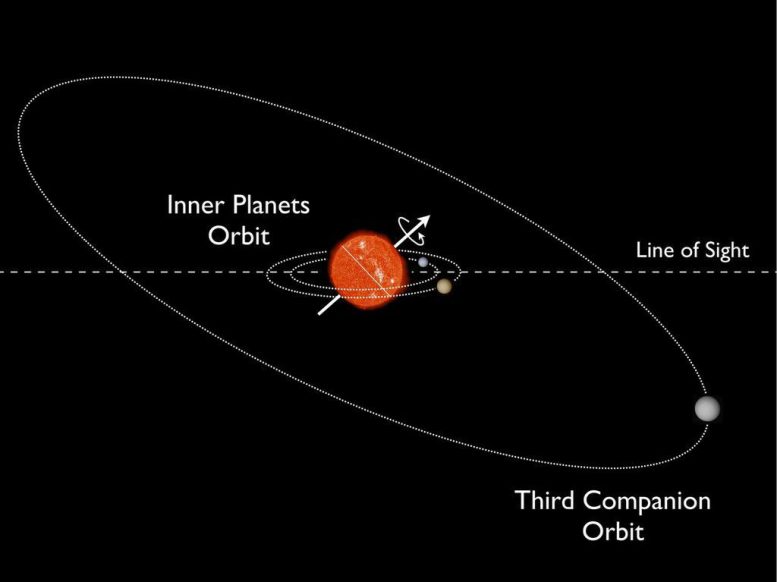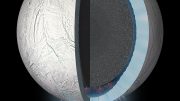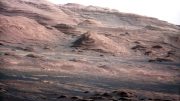
The Kepler-56 planetary system features two inner planets orbiting at a severe tilt to their host star — even though there’s no closely orbiting “hot Jupiter” in the system. Credit: Daniel Huber/NASA’s Ames Research Center
In a newly published study, researchers from NASA’s Ames Research Center and Iowa State University detail the discovery of two planets in the Kepler-56 planetary system that orbit the host star at a severe tilt.
Ames, Iowa – Using data from NASA’s Kepler space telescope, an international team of astronomers has discovered a distant planetary system featuring multiple planets orbiting at a severe tilt to their host star.
Such tilted orbits had been found in planetary systems featuring a “hot Jupiter,” a giant planet in a close orbit to its host star. But, until now, they hadn’t been observed in multiplanetary systems without such a big interloping planet.
The discovery is reported in a paper, “Stellar Spin-Orbit Misalignment in a Multiplanet System,” published in the October 18 issue of the journal Science. The lead author of the study is Daniel Huber of NASA’s Ames Research Center in Mountain View, California Steve Kawaler, an Iowa State University professor of physics and astronomy and a leader of the Kepler Asteroseismic Investigation, is a co-author.
“This is a new level of detail about the architecture of a planetary system outside our solar system,” Kawaler said. “These studies allow us to draw a detailed picture of a distant system that provides a new and critical test of our understanding of how these very alien solar systems are structured.”
Kawaler contributed as part of the research team that studied regular changes in the brightness of the host star, Kepler-56, an aging red giant star with two planets in close orbits and a massive third planet in a distant orbit. By measuring those oscillation frequencies and using spectroscopy data about the star’s temperature and chemistry, researchers measured the star’s diameter and other properties.
The paper reports Kepler-56 is more than four times the radius of our sun. Its mass is also 30 percent greater than our sun. It is about 3,000 light-years from Earth.
Kawaler said he was also part of the team that used studies of the changes in brightness to help determine the tilt of the rotation axis of Kepler-56. That axis is tilted 45 degrees to the line of sight from Earth.
Generally, Kawaler said, the simplest way for a planetary system to develop is with the orbits in the same plane as the host star’s equator. That typically indicates the planets formed from a thin disk of dust and gas surrounding the host star. The planets in our solar system all orbit within 7 degrees of the plane of the sun’s equator.
A planet’s orbit that tilts away from other planets or from the host star’s equator can mean the planet had a traumatic youth, Kawaler said. It may have been pulled into a different plane after encountering another planet or planets. That’s generally the case with migrating hot Jupiters. They change their orbits after encounters with other planets and material, and therefore have a higher chance of tilted orbits.
In the case of Kepler-56, however, the more massive outer planet seems to be maintaining the tilted orbits of the two inner planets.
“It issues a continuous tug on the orbit of the smaller ones, pulling them into their inclined orbits,” Kawaler said.
All of those Kepler-56 observations, the researchers noted in their Science paper, add up to firm evidence that tilted planetary orbits are possible even in systems that don’t contain a hot Jupiter.
Reference: “Stellar Spin-Orbit Misalignment in a Multiplanet System” by Daniel Huber, Joshua A. Carter, Mauro Barbieri, Andrea Miglio, Katherine M. Deck, Daniel C. Fabrycky, Benjamin T. Montet, Lars A. Buchhave, William J. Chaplin, Saskia Hekker, Josefina Montalbán, Roberto Sanchis-Ojeda, Sarbani Basu, Timothy R. Bedding, Tiago L. Campante, Jørgen Christensen-Dalsgaard, Yvonne P. Elsworth, Dennis Stello, Torben Arentoft, Eric B. Ford, Ronald L. Gilliland, Rasmus Handberg, Andrew W. Howard, Howard Isaacson, John Asher Johnson, Christoffer Karoff, Steven D. Kawaler, Hans Kjeldsen, David W. Latham, Mikkel N. Lund, Mia Lundkvist, Geoffrey W. Marcy, Travis S. Metcalfe, Victor Silva Aguirre and Joshua N. Winn, 18 October 2013, Science.
DOI: 10.1126/science.1242066
arXiv:1310.4503









Be the first to comment on "Astronomers Discover Misaligned Planets in a Distant Planetary System"